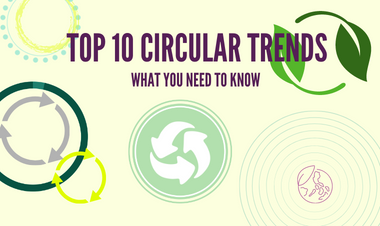Top 10 Circular Trends In The Waste Industry
Before we talk about the top 10 circular trends in the waste industry, we need to explore what the term circular economy means.
Globally we have a very wasteful economic model, we take materials from the Earth, we produce products that are then thrown away as waste when they reach their end of life (a linear economy). In a circular economy, waste is not produced as the goal, instead things are created to last, or a product is remade and repurposed to extend its lifecycle.
We’ve have summed up the 10 up and coming circular trends and innovations that could revolutionise the way we view waste.
Upcycling food waste
It’s estimated that each year the food waste generated across the world accounts for between 8 and 10% of global greenhouse gases. This statistic is encouraging businesses and scientists to find new ways to reuse the worlds unwanted food.
Biomass valorisation, is an increasingly popular method to create useful products from food waste.
Examples of this include:
- Bread to beer
- Coffee grounds to ink
- Cosmetics and rice to furniture.
Due to the variety of forms food waste comes in the possibilities for this technology are endless!
The ‘repair’ movement
With the aim of eradicating excessive consumption, 2021 saw the UK government introduce a legislation to make electrical products, like TVs, washing machines and fridges easier to repair.
Manufacturers are now legally required to make spare parts available to buy, enabling consumers to repair and not replace.
Loop deposit systems
Loop deposit systems are gaining popularity with both governments and brands alike.
The premise is to charge the consumer a small deposit to be given a refillable container, instead of a disposable one. Both McDonalds and Tesco are currently trailing these systems across a selection of outlets.
The construction industry supports a platform called “Loop” and recently launched a Pallet Loop scheme enabling wooden pallets to be reused time and time again.
Find out more about Loop here Loop – A Global Platform for Reuse (exploreloop.com)
Waste-based building materials
The Royal Academy of Engineering named and shamed the building industry’s current linear economy used within most of the building sector as ‘unsustainable’. This has led to some to brilliant innovative ideas to create building materials from waste.
Smile Plastics for example use discarded cosmetics bottles, yogurt pots and chopping boards to make furniture.
Battery recycling
The 2030 deadline banning the production of petrol and diesel cars is fast approaching. This has seen a drastic rise in the production of electric vehicle batteries.
Lithium is a key component of rechargeable batteries and it’s a scarce resource. The sparsity of lithium has fuelled the development of ‘urban mining’. This simply explains the process of extracting valuable materials such as lithium and gold from WEEE Waste.
If you have battery recycling requirements for your business, learn more about how we can help.
Recycling E-waste
E-waste is one of the fastest growing waste streams, with volumes expected to be double what they were in 2014 as soon as 2030!
This is has led scientists to innovating the way they extract iron, silver and platinum from the complex WEEE waste stream.
Greenzone provide WEEE recycling as part of our services, contact us today for a quote.
Apps and technology
Almost 90% of the UK’s population own a smart phone. Entrepreneurs are now creating apps to solve and track waste related problems.
For example, the app ‘Utter Rubbish’ informs users of bin collection information and even allows users to report fly-tipping. Another food sharing app named Olio has partnered with Tesco to divert five million meals from going to waste within the first year.
Biomaterials
We all know the importance of getting rid of single use plastics. Biomaterials could be the answer to this global problem.
Types of bacteria are being used to create bioplastics and biomaterials. These are already being used to make concrete and artificial leather. DS Smith, a packing manufacturer has recently boosted research into using natural fibres instead of traditional packing materials like plastics and cardboard.
Hydrogen from waste
2021 saw the government unveil a vision to stimulate a ‘hydrogen economy’ in the UK. The ‘clean’ power produced by hydrogen cells, produces water as a by product of the chemical reaction process. These cells are already being used to power cars, fork-lift trucks and even planes!
Because energy is still needed many organisations are now looking at developing new methods of generating hydrogen from solid waste.
The UK Government has pledged 5M to a scheme developing the technology that can generate hydrogen from biomass and waste
Digital tracking for garments
Fast fashion accounts for around 10% of global pollution, and according to WRAP the demand for raw materials is set to triple in the next 27 years!
Companies are now investigating digital tagging systems which will allow brands to track products after they are sold. Also enabling customers to access information including the garments carbon footprint and how to recycle it at the end of its life.
Brands being able to track their garments through the entire supply chain is a big step towards a far more circular fashion industry.


